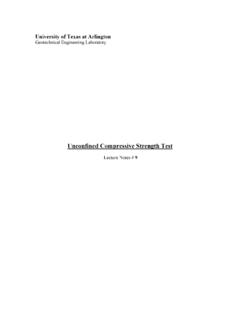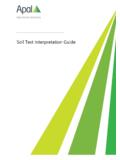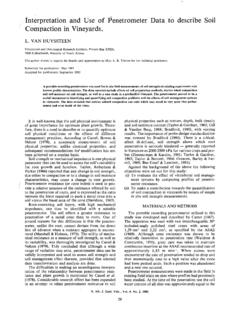Transcription of Soil Test Interpretation Guide - Center for Regional Food ...
1 soil Test Interpretation Horneck, Sullivan, Owen, and HartEC 1478 Revised July 2011 ContentsNitrogen (N) ..2 Phosphorus (P) ..3 Cations (K, Ca, and Mg) ..4 Sulfate-sulfur (SO4-S) ..5 Micronutrients (B, Zn, Cu, Mn, Fe, and Mo) ..5 Chloride (Cl ) ..7pH, lime requirement (LR) ..7 Sodium (Na) ..9 Soluble salts ..9 Organic matter or soil carbon ..9 Cation exchange capacity (CEC) ..10 For more information ..12 Regular soil testing is an important element in nutrient management. You can use soil tests as a diagnostic tool or to identify trends through time.
2 To obtain meaningful test results, you must sample soil correctly, at the same time each year, and you must maintain more information, see the following in the OSU Extension Catalog ( ): soil Sampling for Home Gardens and Small Acreages (EC 628); Monitoring soil Nutrients Using a Management Unit Approach (PNW 570); Monitoring soil Nutrients in Dryland Systems Using Management Units (EM 8920). soil testing laboratory methods vary, which may influence results and sufficiency ranges. Therefore, the sufficiency ranges in this publication are accurate only for the test methods tests are used to measure soil nutrients that are expected to become plant-available.
3 They do not measure the total amounts of nutrients in soil . Measurements of total nutrient content are not useful indicators of sufficiency for plant growth, because only a small portion of the nutrients are plant-available. Roots take up plant-available nutrients as positively or negatively charged ions from the soil (table 1). soil test results (see figure 1) can be viewed in three categories: (1) low or yes, a fertilizer addition will likely increase growth and yield; (2) high or no, a fertilizer addition will not likely increase growth or yield; and (3) intermediate or maybe, a fertilizer addi-tion may increase growth or yield.
4 Categorization of soil test results into yes, no, and maybe assists understanding the limits and benefits of using soil test results for making nutrient 1. Plant-available nutrient used by plantCations (+): NitrogenNH4+ PotassiumK+ CalciumCa2+ MagnesiumMg2+ ManganeseMn2+ CopperCu2+ ZincZn2+Anions ( ): NitrogenNO3 PhosphorusH2PO4 and HPO42 SulfurSO42 BoronH3BO3 and H2BO3 MolybdenumHMoO4 and MoO42 ChlorideCl 2 Most soil test values do not vary greatly from year to year. However, some soil and environmental conditions cause fluctuations in measurements such as pH and nitrate-nitrogen.
5 Drastic changes in test values year to year may indicate an unrepresentative soil sample or a laboratory error. When in doubt, submit a new sample or ask the lab to repeat the control programs for agricultural soil test-ing laboratories include North American Proficiency Testing (NAPT, ). This program is overseen by the soil Science Society of America and is designed to promote quality, repro-ducible soil testing publication provides general guidelines for interpreting soil test results. Guidelines for specific crops are available in many other publications.
6 If a nutrient management/fertilizer Guide for the crop in which you are interested is available, use it instead of the general information in this Guide . Nutrient management/fertilizer guides for Christmas trees, wheat, sweet corn, silage or field corn, peppermint, blueberries, caneberries, several grasses grown for seed, carrots grown for seed, cranberries, hops, pastures, tree fruits and nuts, alfalfa, and onions are available from OSU and PNW Extension Publishing through the OSU Extension Catalog (http:// ). For potato nutri-ent management recommendations in Oregon, use Washington State University s Nutrient Management Guide : Central Washington Irrigated Potatoes (EB1882, )Nitrogen (N)Plant-available nitrogen (nitrate and ammonium)The plant-available forms of nitrogen are ammonium-N (NH4-N) and nitrate-N (NO3-N).
7 The abbreviation NH4-N means nitrogen in the ammonium form, and NO3-N means nitrogen in the nitrate form. soil concentrations of NO3-N and NH4-N depend on biological activity and therefore fluctuate with changes in conditions such as tem-perature and moisture. Nitrate is easily leached from the soil with high rainfall or excessive irriga-tion. soil tests can determine NO3-N and NH4-N Figure 1. soil test value vs. probability of crop yield response to nutrient addition. Crop yield increase due to nutrient addition is likely at low soil test values and unlikely at high soil test values.
8 (Chart Oregon State University. Prepared by Dan M. Sullivan.)Differing fertilizer recommendation philoso-phies can provide multiple recommendations from the same soil test results. For example, nutri-ent application recommendations of land-grant university Extension services in the western United States are based on the philosophy that nutrients should only be applied when an economic yield increase is likely. In contrast, another philosophy for nutrient application is soil test level maintenance, commonly used in the midwestern United States.
9 soil test level maintenance is accomplished by fertil-izing nutrients removed by crop harvest. Nutrients are applied even though the soil test level for these nutrients may be concentrations vary with soil depth, which affects soil test results. To determine the proper sampling depth, you must consider the purpose of the soil test. To estimate fertilizer requirement prior to planting, sample soil to the depth where most root activity will occur, usually a depth of 6 to 12 inches. Shallow sampling, 2 to 3 inches, is sometimes used to evaluate fertilizer need in perennial crops where fertilizers have repeatedly been applied to the soil surface.
10 A combination of sampling depths may be necessary to diagnose problems in more information, see the following in the OSU Extension Catalog ( ): Evaluating soil Nutrients and pH by Depth in Situation of Limited or No Tillage in Western Oregon (EM 9014).3concentrations at the time of sampling but do not reflect future nitrogen mineralization test estimates sea-sonal N supply from a sample collected for wheat during late January. This test is only used for soft white winter wheat production in western more information, see the following in the OSU Extension Catalog ( ): Using the Nitrogen Mineralization soil Test to Predict Spring Fertilizer N Rate for Soft White Winter Wheat Grown in Western Oregon (EM 9020).







